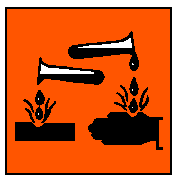International Chemical Safety Cards
| PHOSPHORIC ACID | ICSC: 1008 |
PHOSPHORIC ACID |
 |
| TYPES OF HAZARD/ EXPOSURE |
ACUTE HAZARDS/ SYMPTOMS |
PREVENTION | FIRST AID/ FIRE FIGHTING |
| FIRE | Not combustible. Contact with
common metals produces hydrogen gas which forms flammable mixtures with air. Gives off
irritating or toxic fumes (or gases) in a fire. |
NO contact with metals,
aldehydes, cyanides, mercaptans and sulfides. |
In case of fire in the
surroundings: all extinguishing agents allowed. |
| EXPLOSION | |
|
In case of fire: keep drums,
etc., cool by spraying with water. |
| EXPOSURE | |
AVOID ALL CONTACT! |
|
| INHALATION | Burning sensation. Cough.
Laboured breathing. Shortness of breath. Sore throat. Unconsciousness. Symptoms may be
delayed (see Notes). |
Ventilation. |
Fresh air, rest. Half-upright
position. Artificial respiration if indicated. Refer for medical attention. |
| SKIN | Redness. Pain. Blisters. |
Protective gloves. Protective
clothing. |
Remove contaminated clothes.
Rinse skin with plenty of water or shower. Refer for medical attention. |
| EYES | Redness. Pain. Blurred vision.
Severe deep burns. |
Safety goggles or eye protection
in combination with breathing protection. |
First rinse with plenty of water
for several minutes (remove contact lenses if easily possible), then take to a doctor. |
| INGESTION | Abdominal cramps. Burning
sensation. Confusion. Laboured breathing. Sore throat. Unconsciousness. Weakness. |
Do not eat, drink, or smoke
during work. |
Rinse mouth. Do NOT induce
vomiting. Rest. Refer for medical attention. |
| SPILLAGE DISPOSAL | STORAGE | PACKAGING & LABELLING | ||
| Sweep spilled substance into
containers. Cautiously neutralize remainder. Carefully collect remainder, then remove to
safe place (extra personal protection: self-contained breathing apparatus). |
Separated from food and
feedstuffs, metals, alcohols, aldehydes, esters, phenols, ketones, sulfides, cyanides,
organic peroxides. Cool. Dry. Keep in a well-ventilated room. |
Do not transport with food and
feedstuffs. C symbol R: 34 S: 26 UN Hazard Class: 8 UN Packing Group: III |
||
| SEE IMPORTANT INFORMATION ON BACK | ||||
|
||||